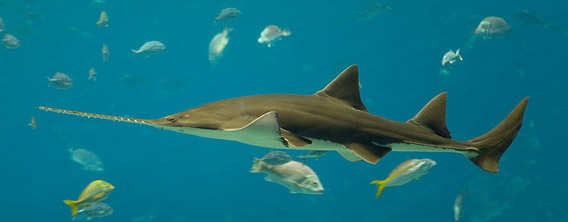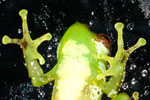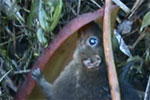
A smalltooth sawfish (Pristis pectinata) at an aquarium in Georgia. Photo by: Diliff.
Although all seven species of sawfish are nearly extinct, scientists have spent little time studying these vanishing species. However that is changing as a new study in Current Biology sheds light on the sawfishes’ most distinguishing feature: its long toothed snout, which gives the fish its name.
“I was surprised to see how skilled sawfish are with their saw,” said co-author Barbara Wueringer of the University of Queensland in a press release. “They use their saw to impale prey on the rostral teeth by producing several lateral swipes per second.”
Before Wueringer’s research, it was generally assumed that sawfish used their snout to sift through sand seeking prey. However, studying sawfish in captivity, Wueringer found that the sawfish wielded its weapon far more dramatically.
“Their strikes were sometimes strong enough to split [dead] fish in half,” Wueringer says, who observed with hidden cameras how sawfish in captivity attacked the already-dead fish thrown to them. After bifurcating their prey, they would employ the saw to swipe the fish onto the floor and only then eat.
But this is not the only application for the sawfishes’ snout. Past research by Wueringer found that the snouts sport thousands of electroreceptors, which allow the sawfish to detect prey by sensing their electric fields. In addition, the skin is pocked by tiny canals that sense movement in the water. These attributes allow the sawfish to locate prey in their lightless habitats. Once located, prey is quickly dispatched with the saw.
“Now we know that sawfish are not sluggish bottom dwellers as previously believed, but agile hunters that hunt in the three-dimensional space of the water,” Wueringer says.
Found mostly in the tropics, the sawfish, a part of the ray family, swim between freshwater and seawater. Unfortunately every one of the seven species of sawfish are classified as Critically Endangered by the IUCN Red List, the highest category before extinction. Sawfish have been decimated as by-catch, since their saw snouts easily get caught in fishing equipment. In addition, the group has been over-harvested for food, traditional medicine, as curios, and for captivity in aquariums. Their future looks bleak as many have vanished from known habitats and populations are highly fragmented. Despite their rarity, some sawfish are still targeted by fishermen and lack any protection whatsoever.
Related articles
Tiny tarsier makes big, ultrasonic noise

(02/13/2012) The Philippine tarsier (Tarsius syrichta), a 5-inch tall Southeast Asian primate, has long resembled a ventriloquist’s doll. It would open its mouth as though chattering away, but researchers heard nothing. Now, a new study in Biology Letters has found out why: the Philippine tarsier communicates ultrasonically, surpassing all other primates, and nearly all terrestrial mammals, in its ability to create sounds in the upper registry.
Frog perfume? Madagascar frogs communicate via airborne pheromones
(01/25/2012) Researchers have found that some frogs in Madagascar communicate by more than just sound and sight: they create distinct airborne pheromones, which are secreted chemicals used for communicating with others. A paper published in Angewandte Chemie International Edition relates that some male members of the Mantellinae family in Madagascar use large glands on their inner thighs to produce airborne pheromones. Interestingly, the pheromones are structurally similar to those produced by insects. Scientists have identified frogs producing water-borne pheromones before, but this is the first instance of airborne.
New species of frog sings like a bird

(12/12/2011) If you’re trudging through the high-altitude rainforests of northern Vietnam and you hear bird song, you might want to check the trees for frogs. Yes, that’s right: frogs. A new species of tree frog has been discovered in Vietnam that researchers say has a uniquely complex call that makes it sound more like a bird than a typical frog. Discovered in Pu Hoat Proposed Nature Reserve, the new species, dubbed Quang’s tree frog (Gracixalus quangi), dwells in the forests at an altitude 600-1,300 meters (nearly 2,000-4,265 feet).
Small mammals use Borneo pitcher plant as toilet in exchange for nectar

(11/08/2011) Tree shrews and nocturnal rats in the forests of Borneo have a unique relationship with carnivorous pitcher plants. The mammals defecate, and the pitchers are happy to receive. A study published on May 31 in the Journal of Tropical Ecology shows a species of giant mountain pitcher plants (Nepenthes rajah) supplements its diet with nitrogen from the feces of tree shrews (Tupaia montana) that forage in daylight and summit rats (Rattus baluensis) active at night. When the small mammals lick nectar from the underside of the pitcher’s lid, they stand directly over the jug-shaped pitcher organ.
Rat uses ‘poison arrow’ toxin from tree to defend against predators
(08/02/2011) The African crested rat, a rodent from East Africa, applies to plant toxin from tree bark to make itself poisonous, reports a new study published in Proceedings of The Royal Society B..